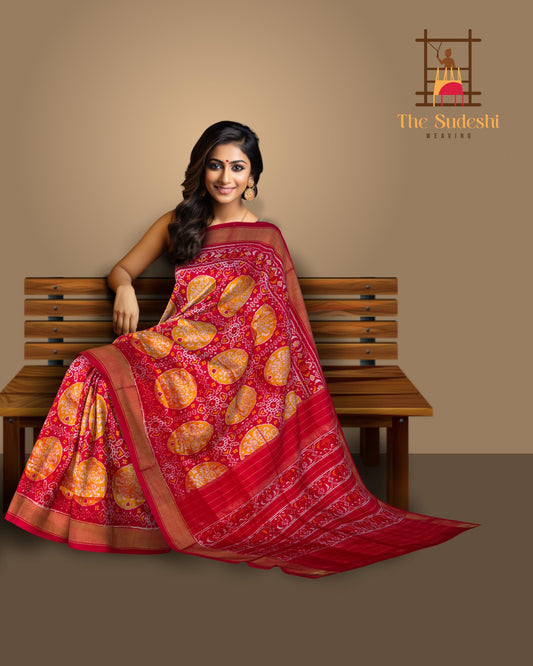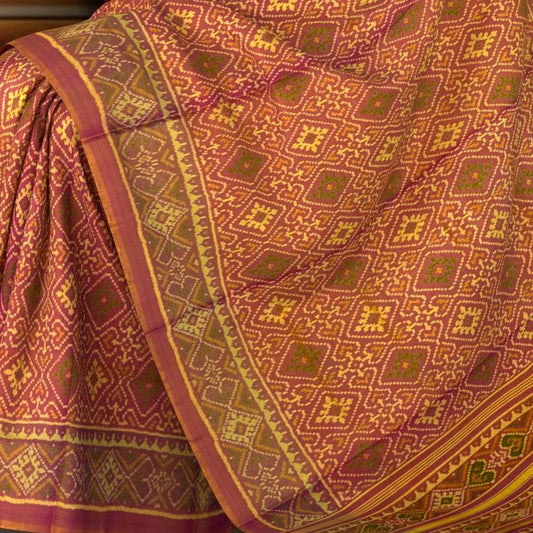Challenges in the Patola Saree Industry: Imitations, Trends, and Preservation
The rich and intricate craft of Patola sarees, originating from Patan in Gujarat, has a storied history dating back centuries. These handwoven silk sarees, known for their vibrant colors and complex geometric patterns, are not just garments but a symbol of heritage and artistry. However, the Patola saree industry faces several significant challenges that threaten its existence and growth. This blog explores three primary challenges: competition from cheaper imitations, the impact of changing fashion trends, and the efforts to protect and promote this exquisite craft.
Competition from Cheaper Imitations
One of the most pressing issues for the Patola saree industry is the proliferation of cheaper imitations. Authentic Patola sarees are known for their labor-intensive production process, often taking months to complete a single piece. This meticulous craftsmanship is reflected in their price, making them a luxury item. However, the market is flooded with machine-made replicas and low-quality imitations that are sold at a fraction of the price.
These imitations not only undermine the value of genuine Patola sarees but also deceive customers who may not be able to distinguish between authentic and fake products. The availability of cheaper alternatives has significantly impacted the sales of original Patola sarees, putting financial strain on the artisans who depend on this craft for their livelihood.
Addressing the Issue
To combat the influx of imitations, several measures can be taken:
-
Awareness Campaigns: Educating consumers about the unique characteristics of authentic Patola sarees can help them make informed purchasing decisions. Workshops, exhibitions, and social media campaigns can be effective in spreading awareness.
-
Geographical Indications (GI) Tags: Obtaining a GI tag for Patola sarees can help protect the craft from counterfeit products. This tag ensures that only sarees produced in the specific region and using traditional methods can be sold as Patola sarees.
-
Quality Certification: Establishing a certification process for genuine Patola sarees can provide an additional layer of authenticity. Certified products can bear a unique mark or label that guarantees their origin and quality.
Impact of Changing Fashion Trends
Fashion is inherently dynamic, and staying relevant in the ever-evolving fashion industry is a constant challenge. While Patola sarees have a timeless appeal, modern consumers often gravitate towards contemporary styles and trends. This shift in preference can result in declining demand for traditional attire like Patola sarees.
The younger generation, in particular, tends to favor more casual and versatile clothing options. The intricacy and formality of Patola sarees might not align with their fashion sensibilities, leading to a potential disconnect between the craft and its prospective buyers.
Adapting to Trends
The Patola saree industry can adapt to changing fashion trends without compromising its essence:
-
Innovative Designs: Introducing modern design elements and contemporary color palettes can attract younger customers while maintaining the traditional weaving techniques. Collaborations with fashion designers can result in fresh, innovative creations.
-
Diversifying Product Range: Expanding the product range to include items like scarves, stoles, and accessories can cater to a broader audience. These smaller, more versatile items can be incorporated into daily wear, making the craft more accessible.
-
Marketing and Branding: Leveraging digital marketing and social media platforms can help reach a wider audience. Engaging content, influencer partnerships, and targeted advertising can create a buzz around Patola sarees and highlight their unique appeal.
Efforts to Protect and Promote the Craft
Despite the challenges, there are numerous efforts to protect and promote the Patola saree industry. Preserving this ancient craft requires a multifaceted approach involving government support, community initiatives, and individual contributions.
Government Initiatives
-
Financial Assistance: Providing financial support and subsidies to artisans can help sustain their craft. Government schemes and grants can alleviate some of the economic pressures faced by the weavers.
-
Skill Development Programs: Training programs and workshops can equip artisans with new techniques and business skills. This can enhance their productivity and enable them to market their products more effectively.
-
Cultural Preservation Projects: Collaborations with cultural organizations and museums can help document and showcase the history and significance of Patola sarees. This not only educates the public but also instills a sense of pride among the artisans.
Community and Individual Efforts
-
Collective Marketing: Forming cooperatives or artisan groups can provide a platform for collective marketing and sales. This can increase bargaining power and open up new markets for their products.
-
Local Support: Encouraging local communities to support the artisans by purchasing their products can create a sustainable market. Festivals, fairs, and local events can serve as venues for promoting Patola sarees.
-
Patronage and Advocacy: Individuals who appreciate the craft can play a crucial role by becoming patrons and advocates. Supporting authentic Patola sarees through purchases and word-of-mouth can help sustain the industry.
Conclusion
The Patola saree industry, with its rich heritage and unparalleled craftsmanship, stands as a testament to India's vibrant cultural tapestry. However, it faces significant challenges from cheaper imitations, changing fashion trends, and the need for sustained efforts to protect and promote the craft. By raising awareness, adapting to modern trends, and fostering a supportive environment for artisans, we can ensure that this exquisite art form continues to thrive for generations to come. Supporting the Patola saree industry is not just about preserving a piece of fabric; it's about cherishing a legacy that embodies the spirit of tradition and innovation.







Leave a comment
Please note, comments need to be approved before they are published.